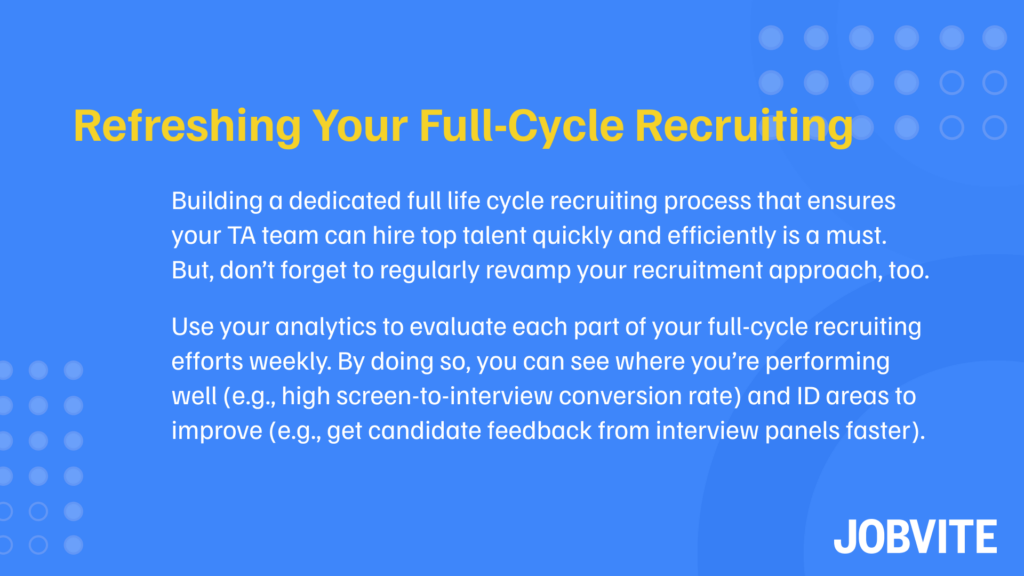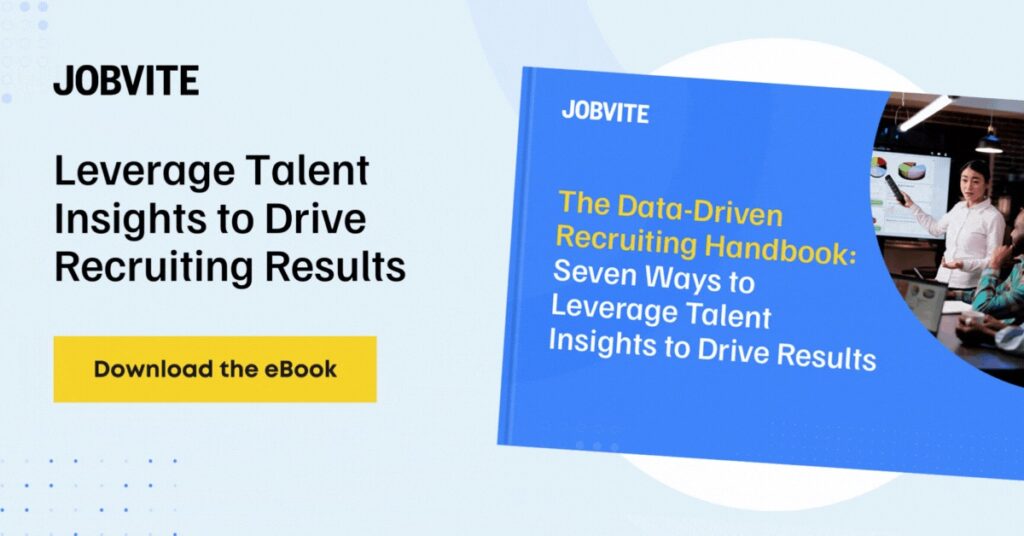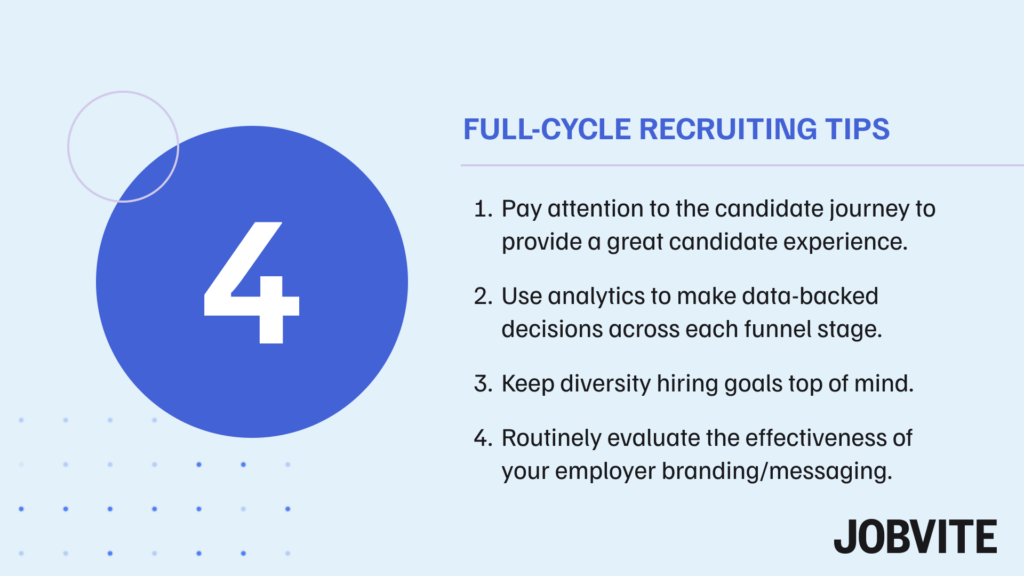Evolve and adapt. Without regular assessment and constant optimization of your full-cycle recruiting process, you and your talent acquisition team won’t be able to minimize the person hours and resources spent on filling open roles and closing requisitions in an increasingly efficient manner.
It’s not just on your TA team to routinely make progress in terms of improving each part of its recruiting process, of course. It’s a twofold approach, really, to ensure your hiring team at large can consistently identify, engage, and convert your ideal candidate in a predictable and scalable way:
- Your talent leader and operations manager need to have a constant eye on your recruitment analytics so they can share actionable insights with and recommend changes to each recruiter.
- Once they have said data and suggestions, your recruiters and hiring managers can ensure each subsequent recruitment cycle (ones tied to future reqs) is faster and more efficient than the last.
In other words? Elevating the quality of your full-cycle recruiting is a true team effort — and a process that has many moving parts. Here’s how you can enhance your TA efforts in the long run.

Benefits of full-cycle recruiting
As with any business endeavor or initiative, there are pros and cons of full life cycle recruiting.
That said, the only “downsides” (if you can even call them that) of this talent acquisition method is not being able to keep up with hiring demand, due to insufficient in-house recruiting headcount, budget, and/or resources. Of course, that’s likely not a problem for enterprise TA teams like yours.
With that in mind, here are the (many) pros of implementing the popular recruitment approach.
A better-run recruiting cycle and hiring process
A well-coordinated full-cycle recruiting process fills open positions more quickly. Plain and simple.
By proactively building relationships with passive and active candidates across multiple channels (social media, job boards, etc.) and using data to assess and improve their efforts to execute standard TA tasks (nurturing top talent via email and/or text, conducting interviews and background checks), recruiters increase their chances of discovering qualified candidates.
This ensures hiring managers always have a sufficient pool of premier prospects to choose from. In turn, this reduces delays in filling job vacancies on their teams due to a lack of talent to engage.
A concerted team focus on candidate experience
When all hiring stakeholders know their distinct function within the full-cycle recruiting process, every part of it runs smoothly. Equally as important, though, it also ensures job seekers your team engages for openings have an enjoyable experience. (Something not all enterprise employers prioritize today.)
Proactively communicate with candidates in each full-cycle recruiting stage.
From the moment an active job seeker applies for an open role or sourced prospects engages with your nurture messaging, to when said candidate accepts a job offer (or otherwise sees their respective recruitment journey end), their experience with your hiring team must remain top of mind.
By doing so, your TA team can help alleviate any anxiety they might feel when speaking with your team regarding the role and ensure that, whatever the outcome, their content with their experience interacting with your recruiting staff, hiring managers, and other interview panelists is a fond one.
Streamlined, end-to-end recruitment operations
Arguably the biggest benefit of full-cycle recruiting is being able to tackle each TA task in a highly organized manner — and use data tied to your hiring team’s collective efforts after to “upgrade” hiring operations each requisition is closed (i.e., post-recruitment cycle, when a new hire is made.)

Improving your full-cycle recruiting process
Establishing a dedicated talent acquisition approach is one thing. But, it’s equally essential to keep your full-cycle recruiting process running smoothly. That means abiding by FCR best practices.
Here are four specific ways you can systematically strengthen your end-to-end recruitment efforts.
1) Pay close attention to the candidate journey
A critical aspect of attracting and hiring exceptional candidates is the ever-important candidate journey. This encompasses every interaction a potential hire has with your business early on.
From the initial discovery of a role, all the way to receiving an offer letter. (Or getting passed on.)
To refresh your recruiting process and enhance the candidate experience, start by examining your org’s online presence, application process (and ease), and structured interview procedures.
- What areas of your recruiting cycle can be improved (or even sped up)?
- Are you keeping leads informed and engaged during the hiring process?
- Do your job postings reflect your company values, culture, and mission?
Evaluating and improving these aspects will lead to a more seamless and enjoyable journey for potential hires, further enhancing your company’s reputation and appeal.
2) Use analytics to make data-backed decisions
Data-driven decision-making is a key component of effective recruiting strategies. By utilizing analytics and data points in your recruitment process, you can gain valuable insights into your talent acquisition outcomes, identify trends, and make data-backed decisions to improve your approach.
To leverage talent insights in your recruiting process, audit your current analytics setup (i.e., the solutions in your tech stack) practices.
Similarly, ensure your entire recruiting staff and TA team members evaluate the right set of recruitment metrics to gauge your success (and pinpoint areas for improvement) over time.
This can include tracking candidate source performance, time to fill, quality of hire, applicant conversion rates, and more. By combining data and creative problem-solving, you’ll be able to make informed decisions to continually refine your ways of working and better your results.

3) Keep your org’s DEI hiring objectives top of mind
Consider diversity and inclusion when refining your FCR process. To make strides in this facet of your TA strategy, investigate your company’s current diversity hiring practices and bias mitigation efforts.
Are you partnering with diverse job boards and networking groups to advertise active and upcoming roles? How about utilizing candidate assessment methods that minimize recruiting biases, such as implementing blind hiring techniques or providing standardized interviews?
Take deliberate and conscious actions to improve diversity in the hiring process.
That way, you’ll more naturally attract a diverse range of talented candidates. Both active diverse job seekers and passive candidates of various backgrounds who express interest in job openings.
4) Gauge the effectiveness of your employer branding
Your employer branding is crucial for attracting top candidates and retaining talented employees. A strong employer brand helps potential hires understand the unique selling points of working for your company beyond just the job description and salary.
To optimize your employer brand, assess your current branding efforts and identify opportunities to create a more authentic and appealing narrative. Take the time to highlight the various facets of your company culture, values, and employee benefits.
Utilize social media and online platforms to showcase success stories, team achievements, and life behind the scenes. By refreshing your employer branding, you’ll be able to attract quality candidates that better align with your company values.
By adapting and evolving your full-cycle recruiting processes over time, you can help your org attract and retain top candidates, leading to increased productivity, innovation, and stability.
Find out how Jobvite can help you thrive in today’s hiring landscape. Schedule a demo to learn how our ATS can elevate the quality of your talent acquisition strategy.





